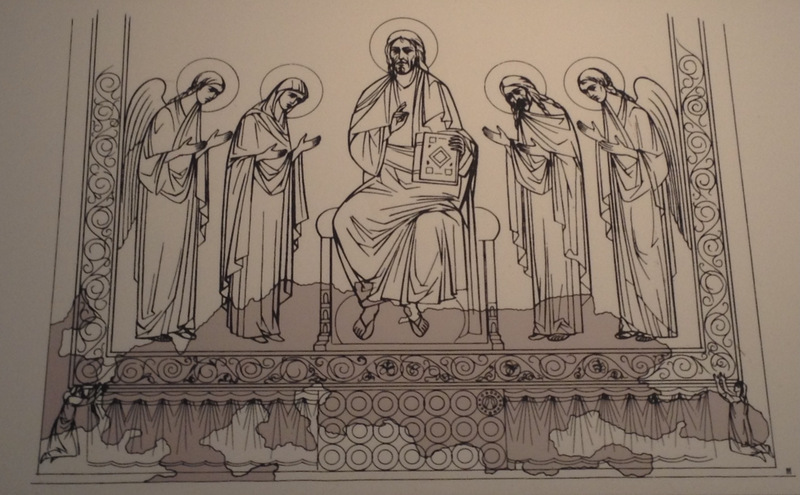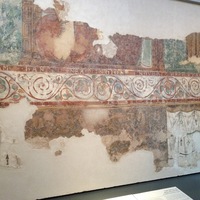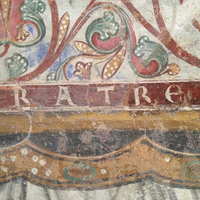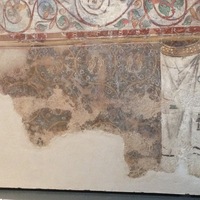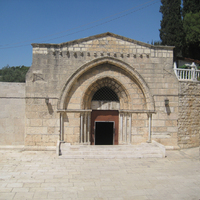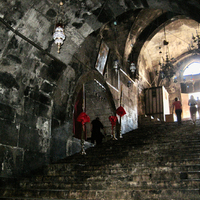Refectory of St. Mary in Jehoshaphat
Type:
Wall paintings,
Monasteries
Date:
Third quarter of twelfth century
Location or Findspot (Modern-Day Country):
Israel
Medium:
Lapis lazuli,
Gold
Dimensions:
ca. 2.7 × 9 m (preserved)
Description:
This large wall painting adorned the refectory of the monastery dedicated to Mary in the Valley of Jehoshaphat outside Jerusalem, a site long associated with the sleep and resurrection of the Virgin. The monastery was restored in the twelfth century during the period of Latin rule in Jerusalem. The finest materials were used in its decoration, including lapis lazuli and gilding along with both fresco and tempera. The monastery was mostly destroyed by Salah al-Din in 1187.
Only the lower portion of the painting is preserved, but enough remains to identify the three figures of the Deesis composition. Additional feet likely belonged to angels. A vegetal scroll separates two lines of a partly preserved Latin inscription. The upper line is drawn from Possidius of Calama's fifth-century vita of St. Augustine. It allegedly decorated Augustine's dining table, so it was appropriate for a monastic refectory: "Whoever enjoys defaming the reputation of those absent will find this table unwelcome to him." In the lower line, "Fratres tacito" is legible: it means "Brothers, keep silent," a general rule in monasteries. During meals, the abbot was probably seated directly under the image of Christ.
The Byzantine Deesis scene was familiar to artists working for European patrons in the Holy Land; it appears in the Melisende Psalter. Queen Melisende was buried in the Jehoshaphat monastery in 1161, in a chamber alongside the twelfth-century staircase that leads down to the Virgin's tomb.
The dado of the refectory wall was painted with fictive textiles: white curtains flank a purple cloth decorated with pearl-edged roundels containing paired birds. Like the Deesis, this pseudo-silk textile conveys familiarity with "Eastern" works, because such textiles had long been produced in Sasanian, Byzantine, and Central realms. By contrast, white curtains were often painted in European church apses. Thus, despite its fragmentary condition, the Jehoshaphat painting reveals a variety of cultural influences consistent with its location in the multicultural twelfth-century eastern Mediterranean.
Only the lower portion of the painting is preserved, but enough remains to identify the three figures of the Deesis composition. Additional feet likely belonged to angels. A vegetal scroll separates two lines of a partly preserved Latin inscription. The upper line is drawn from Possidius of Calama's fifth-century vita of St. Augustine. It allegedly decorated Augustine's dining table, so it was appropriate for a monastic refectory: "Whoever enjoys defaming the reputation of those absent will find this table unwelcome to him." In the lower line, "Fratres tacito" is legible: it means "Brothers, keep silent," a general rule in monasteries. During meals, the abbot was probably seated directly under the image of Christ.
The Byzantine Deesis scene was familiar to artists working for European patrons in the Holy Land; it appears in the Melisende Psalter. Queen Melisende was buried in the Jehoshaphat monastery in 1161, in a chamber alongside the twelfth-century staircase that leads down to the Virgin's tomb.
The dado of the refectory wall was painted with fictive textiles: white curtains flank a purple cloth decorated with pearl-edged roundels containing paired birds. Like the Deesis, this pseudo-silk textile conveys familiarity with "Eastern" works, because such textiles had long been produced in Sasanian, Byzantine, and Central realms. By contrast, white curtains were often painted in European church apses. Thus, despite its fragmentary condition, the Jehoshaphat painting reveals a variety of cultural influences consistent with its location in the multicultural twelfth-century eastern Mediterranean.
Relevant Textbook Chapter(s):
7
Image Credits:
Linda Safran
